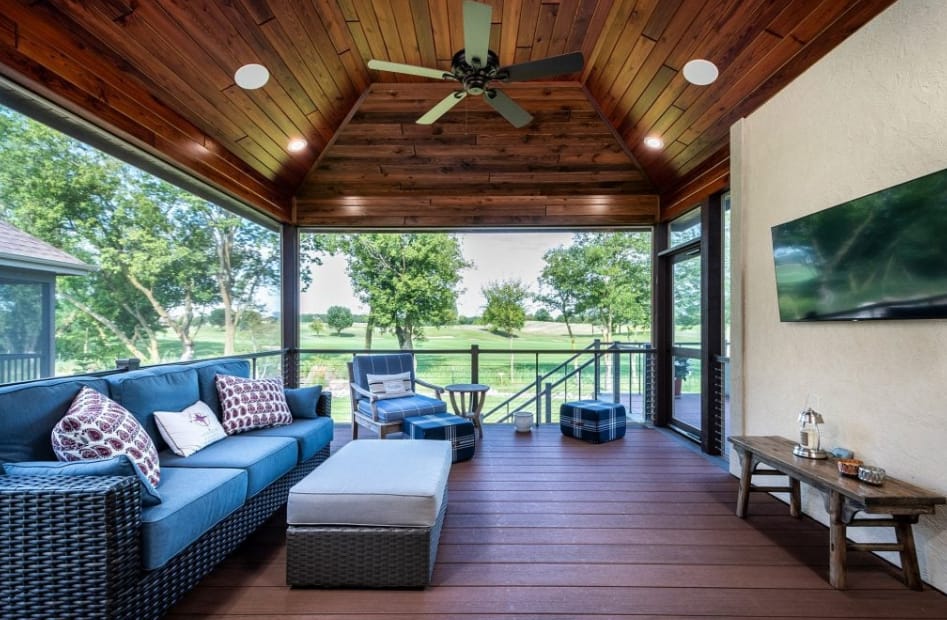Upon entering the room, nothing greets you quite like a ceiling with warmth, character, and timelessness. A tongue and groove ceiling is a transformative addition that brings depth and texture while remaining clean and sophisticated. One of the main reasons is that this type of ceiling is versatile and can be mixed with a variety of designs, making it popular with both modern homes as well as traditional.
Thank you for reading this post, don't forget to subscribe!So what is a tongue and groove ceiling, anyway? Why is it so popular, and how can you put one in your own home? Join us to discover the advantages, installation tutorial, design inspiration, costs, and other details, for this classic style ceiling trend.
What Is a Tongue and Groove Ceiling?
Tongue and groove ceilings are made of wooden planks that fit together, interlocking at the edges. Each board features a “tongue” on one side that fits tightly into the “groove” on the next board over. This makes the surface of the building edge pleasant and also strengthens the overall structure. While tongue and groove panels were historically made from materials like pine, cedar and oak, they now come in a range of finishes to suit any design aesthetic.
This particular ceiling style has lasted through the ages thanks to its artistic roots, dating back to traditional cottages, farmhouses, and even upscale estates. These days it’s frequently employed for a rustic, coastal or even modern aesthetic. If you’re constructing a new home or renovating a current space, a tongue and groove ceiling provides both form and function.
Reasons to Choose a Tongue and Groove Ceiling
You may be asking yourself, “Why are tongue and groove ceilings so special?” In addition to the fact that they are really beautiful, they also have a number of practical benefits that make them worth considering.
Aesthetic Appeal
They add classic character to any space. These warm, textured wooden panels are not like the plain, popcorn-style ceilings. Paint them white for a modern farmhouse aesthetic, leave the natural wood for a rustic touch, or stain them for a sleek finish, and the design possibilities are endless.
Easy Installation
Tongue and groove planks are relatively easy to install thanks to the interlocking nature of the design. With a little patience and the right tools, it can even become a satisfying do-it-yourself project. The process sidesteps the mess and the hassle of other ceiling upgrades, such as drywall. Plus they are light, making them much easier to install.
Durability and Maintenance
Woodwork is durable stuff and your tongue and groove ceiling can last for generations with adequate care. You just need to clean it regularly with a microfiber cloth or a vacuum with a soft brush attachment to keep it looking beautiful. Any one plank can get damaged and all you have to do is replace those panels and you are back in business without having to redo the entire ceiling.
Acoustic Benefits
Wood has natural sound deadening properties. Tongue and groove ceilings also reduce noise, so they are an ideal option for busy homes or even home offices or relaxation spaces.
Versatility Across Styles
Whether as a classic or contemporary finish, tongue and groove ceiling can complement any interior design style. They’re equally suited to cozy cottages and minimalist lofts, providing a tailored finish that knits the whole space together.
How to Install a Tongue and Groove Ceiling
Tongue and groove ceiling installation can be overwhelming, but this how-to makes it doable (and is within most DIYer skillsets). This is how to approach this project:
Step 1. Gather Your Materials
You’ll need:
- Tongue and groove planks
- Measuring tape
- Saw (miter or table saw)
- Nail gun with finish nails
- Chalk line
- Level
- Wood glue (optional)
Step 2. Prep the Surface
There, you can check the ceiling’s surface to make sure it’s clean and level. If needed, clear any things that may obstruct you, such as ceiling fixtures. If you will be installing over drywall, furring strips may be a necessity for added support.
Step 3. Measure and Cut Planks
Find the length and width of your ceiling. Trim the tongue and groove boards to size. Make precise cuts to prevent gaps when installing.
Step 4. Install the First Board
Start in a corner of the ceiling. First, install the first board with the groove side against the wall and the tongue facing out. Secure the plank with a nail gun along the edges, making sure it’s level.
Step 5. Interlock and Secure Planks
Insert the tongue of the next plank into the groove of the previous plank. Slot it in tight for a snug fit, then nail it in place. Repeat until the whole ceiling is done.
Step 6. Trim and Finish
Affix trim or molding around the edges for a finished look. Complete the installation using stain, paint or wood sealant to provide protection, along with the desired aesthetic.

Tips for Creating Tongue and Groove Ceilings
Wondering how to style a tongue and groove ceiling? Here is some inspiration to help you get started:
Coastal Vibes
For a bright, airy appearance, paint your planks white or light blue. Team this with neutral furniture and natural textures such as jute rugs or wicker accents for the ultimate coastal retreat.
Rustic Chic
Add warm tones like honey or walnut and; leave the natural wood grain exposed. This works great in a bedroom, stepped dining area, or cabin, providing a cozy and inviting experience.
Modern Minimalism
Use sleek, long panels, and a seamless finish. Stained them in dark hues, such as charcoal or espresso, for a dramatic look that works well in modern settings.
Unexpected Spaces
Consider installing tongue and groove ceilings in less traditional locations, such as bathrooms, laundry rooms, or closets for an unconventional texture.
How Much Tongue and Groove Ceiling Costs
Thinking about the cost? Here’s what to consider:
Material Costs
Cost varies by the wood type used, with pine being the cheapest ($2–$3 per square foot) and cedar or oak more expensive ($4–$7 per square foot).
Labor Costs
If you’re hiring a pro, budget $3–$5 per square foot installed. DIY-ing, however, can drastically reduce this cost.
Additional Expenses
Add in costs for paint, stains or sealing products, and also tools like nail guns or saw rentals if you don’t have them, she added.
For a 200-square-foot room, a tongue and groove ceiling might run $800–$2,000, on average, depending on materials and labor.
Elevate Your Space with a Tongue and Groove Ceiling
Tongue and groove ceiling is not just a design trend; it’s actually a timeless addition that brings beauty and utility in your house. Its warm, textured finish and long-lasting durability has made this style a staple in homes everywhere.
Whether you’re tackling your next DIY project or hiring someone to install it professionally, a tongue and groove ceiling is an investment you won’t regret. So start planning now and make your ceiling the focal point it was meant to be.
So go ahead and make that decision now!



